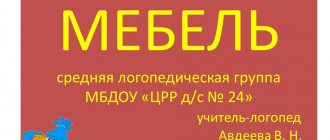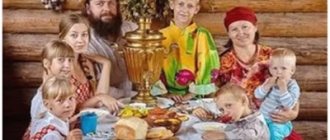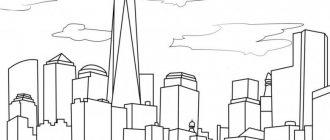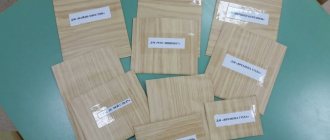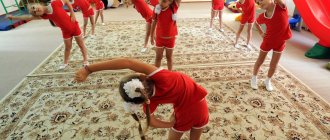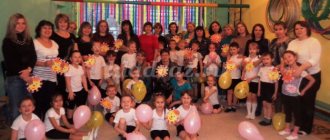"Outdoor games on lexical topics"
Thematic week: “Our kindergarten”.
Outdoor game: “We are funny guys.”
Lines are drawn on two opposite sides of the site, and several circles are drawn on the side. This is the driver's house. The players gather behind the line on one side of the court and say in chorus:
We, funny guys, love to run and jump.
Well, try to catch us! One, two, three, catch us!
After the word “catch!” everyone runs to the opposite side of the site. The driver must catch one of the runners before he crosses the second line. The caught person stands in a circle - the driver's house. Then the children read the poems again and run across the playground in the opposite direction. After 2-3 attempts, they count how many children are caught, choose a new driver and the game continues.
Thematic week: “How bread came to the table”
Relay race: “Combine operators”.
Let's imagine that we are in a field, and wheat is growing on it, and we are combine harvesters. Look, our wheat has grown. And the combine operators need to collect it and put it into the truck (toys). There is wheat in the hoop (field) - children take turns running up with a spoon, scooping grains from the pile and taking them to the car (toy). Who will collect the most grains?
Relay race: “Transport the grain.”
While the combine operators were transporting, they scattered the grains along the road. Now we will all collect the grains together and take them to the mill to make flour. The grains are scattered on the floor in a hoop in one common pile. The children, while the music is playing, all run up together and pick up grain from the common pile and take it to their “mill”.
Thematic week: “My City”
Outdoor game: “Favorite City.”
The participants of the game are located in one “city”. There's a trap in the center. The goal is to run to another city without freezing. Whoever ran to his favorite city without freezing won.
Thematic week: “Toys”.
Outdoor game: “who is most likely to take the toy”
Children move in a circle in a column one at a time to rhythmic music. In the center of the circle is a doll in a hoop. On command, children perform imitative movements (we walk like dolls, we walk like bears, we jump like parsleys). The music stops playing, the children run to the center of the hall to the doll. Whoever touches the fastest is the winner.
Low mobility game: “find and remain silent”
The children turn away, the teacher hides the toy. Children begin to look for a toy, the one who found it approaches the teacher and speaks in his ear where it lies.
Thematic week: “Clothing”.
Relay race: “Washing”.
Children are divided into two teams. A rope with clothespins is stretched near the teams. At the opposite end of the hall there are two basins with clothes. The task of the teams is to run to the basin, take the clothes, run to the rope and hang them on the rope. Whose team is faster?
MAGAZINE Preschooler.RF
THEMED GAME “MY CITY”One of the most important and striking traits of preschoolers is curiosity. Children constantly ask questions and want answers right away. If adults cannot or do not want to explain to children what interests them, their curiosity disappears. Therefore, the only option for introducing children to the world around them is to learn how to answer any questions children may have.
In early preschool age, all the child’s activities are subordinated to one leading need - knowledge of the world around him and himself in it. The main means of satisfying this need still continues to be the sensory (sensual) development of reality through sensations, sensory perceptions, and visual representations. But at this age the thresholds of sensations begin to decrease. This is compensated by an increase in visual acuity and accuracy in distinguishing colors, development of hearing, and accuracy in estimating the weight of objects.
The most characteristic actions are those that allow the child to examine objects, highlight their most typical properties - to separate and combine sensations, giving them the characteristics of sensory standards, generally accepted patterns of perception. Such activity lays the foundation for the transition to a higher stage of development - from visual-effective to imaginative thinking. Rhythm and clarity become the most important conditions for the development of normal perception and comprehension of what is perceived.
It is very important during this period to teach children to name their hometown (village). Encourage them to talk about where they walked on weekends (in a park, square, children's playground, in the country). Pay attention to buildings and remember the streets along which children walk from home to kindergarten, what attractions there are in their hometown, what rivers or even seas are nearby.
To get acquainted with the city, to expand knowledge about the world around us, and to develop communication skills, I offer the game “My City” .
"MY CITY"
Goal: Expanding children's knowledge about the world around them, developing children's communication skills. Forming an idea of classification based on characteristics.
Age: 3-8 years
Number of players: group of children 10-12 people
Necessary equipment: “city” , with marked streets. Sets of geometric shapes (circle, square, triangle, rectangle), primary colors. A set of rectangles with the name of administrative buildings: school, kindergarten, pharmacy, post office, hospital, cafe, store, etc.
Game description: At the beginning of the game, the presenter reads a poem for finger gymnastics “My City” .
I love walking around the city! (They walk with their fingers on their knees) I like to watch, (Turns the head left and right)
I love counting! (clench - unclench their fists) Streets - once! (Bend fingers one at a time)
Area – two! Park - three! And four - I live in an apartment! Five - I'm walking in the park again!
Six - I’ll go to Belaya and look at the water! Seven – “Nalmes” , Palace of Culture, Beautiful and huge,
And it is located in the center! Eight - New Year's tree! Nine - I came across the Great War Monument...
Ten is our cinema! I will go around all of Maykop! (They walk with their fingers on their knees) I love the city very much!
(Clench and unclench their fists)
Children remember and name administrative buildings and stick them in random order on the playing field. Then they place the house figures according to the names of the streets. For example: on VESENNYA (the color with which spring is associated) there can be houses of various shapes, but only green. On the street "MORSKOY" - blue (light blue). And on the street of “MULTI-COLORED SQUARES” there are only squares, but of different colors, etc.
When the city is built, you can proceed to the next stage of the game. Each participant chooses a “house” where he “lives” and gives it a number (you can write it on a figure). A preliminary conversation is held “Where do I live?” . Children name their street and house or apartment number. Then the adult starts the game: “Katya needs to go to the store. What is the best way for her to get through? Children “pave” the way to the desired building, while naming which streets they need to go through and past which buildings. Every child should be a leader. That. children explore the city, learn to navigate the area, and expand their knowledge about aspects of public life.
Play is the most progressive method of teaching preschoolers. It is through play that a child’s abilities such as intelligence, resourcefulness, the ability to think logically, compare and remember are more easily formed. Play makes the learning process less tedious and much more effective.
| Next > |
Summary of educational activities on speech activity in the senior group “Our City”
Topic: “Our city”
Target:
Development of grammatically correct speech and speech creativity.
Tasks:
1. Learn to answer questions in complete sentences;
2. Teach children to select words for signs;
3. Activate children's vocabulary.
4. improve the monologue form of speech, the ability to compose stories using a mnemonic table.
5. Develop children’s coherent speech, teach children to tell stories based on graphic symbols, using mnemonics.
Progress:
Educator:
Guys, we have guests today, let's say hello! Hello. How did you feel when you came to kindergarten today? With good, joyful, cheerful. Let's hold hands and convey our good mood to each other.
All the children gathered around.
I am your friend and you are my friend.
Let's hold hands tighter
And let's smile at each other.
Educator:
Well done, I hope you are in a good mood for the whole day.
Educator:
Guys, I completely forgot about our guest. This is the Snowman. When I went to kindergarten, I met him at our door. He traveled around the cities and ended up in our city. Guys, let’s introduce him and tell him about our city. Do you agree?
Children:
Yes, we agree.
Educator:
Guys and you are a snowman, listen to the poem
There are countless cities on this big planet,
But there is only one native city in the world.
He is the most beloved, the most dear.
Where you were born is your hometown!
Educator:
What do you think this poem is talking about?
Children:
The poem talks about the city.
Educator:
Right. There are a lot of big and small cities in the world. And we will talk about our city.
Educator:
Each city has its own name. What is the name of the city in
which we live?
Children:
The city in which we live is called Vyazemsky.
Educator:
That's right, you and I live in a wonderful city called Vyazemsky.
Educator:
What are the people who live in Vyazemsky called?
Children:
People who live in our city are called Vyazemtsy
Educator:
Children, why is the city called “Vyazemsky”?
Children:
Our city is named after the engineer Orest Polienovich Vyazemsky
Educator:
That's right, the city is named after the engineer Orest Polienovich Vyazemsky, who headed the construction of the Ussuri Railway.
Educator:
Vyazemsky is our small Motherland. Children, what is the Motherland?
Children:
The place where we were born, where we live, where we go to kindergarten, where our mothers and fathers and friends live.
Educator:
Guys, let's say beautiful words about our hometown and give him a bouquet. Take the flowers from the table and go to the board. Place a flower in a vase and call it Vyazemsky?
Children:
Vyazemsky hometown, Vyazemsky cozy city,
(favorite, beautiful, quiet, noisy, green, clean, winter, sunny, crowded, sporty, modern, hospitable).
Educator:
There are many streets in our city. And each street has its own name. For example, I live on K. Marx Street, and you? And you are Snowman, what street do you live on? Let's tell the Snowman what streets there are in our city? (My street is called...) A ball game is being played. Children stand in a circle.
Children:
My street is called...Shkolnaya, Chapaeva, etc.
Educator:
Well done boys .
Educator:
The snowman liked to play, and I suggest playing the game “Say it the other way around.”
For example: long street - short street; narrow street - wide street; clean street - dirty street, ancient street - modern street, near street - distant street, light street - dark street, winter street - summer street, etc.)
Educator:
Well done guys, now let Snowman know what streets we have.
Educator:
The snowman asks, what is the name of the street where our kindergarten is located?
Children:
Our kindergarten is located on Chekhov Street 49
Educator:
Well done.
Educator:
Guys, you walk along familiar streets every day.
Educator:
let's show the Snowman a photo of our city. (Slideshow with photographs of the city).
Educator:
Guys, did you find out what kind of building this is?
Children:
this building is called the city clinic.
Educator:
What is it for?
Children:
To walk is treated.
Educator:
That's right, we go to the clinic for treatment.
Educator:
Who works at the clinic?
Children:
Doctors work at the clinic.
Educator:
But here is a building that preserves the history of our city. Who knows what it's called?
Children:
This building is called the Local History Museum
Educator:
Have you been to the museum? What did you see there?
Children:
Animals, exhibits.
Educator:
Is this building familiar to you?
Children:
This building is called Cinema
Educator:
Why do we go there?
Children:
To watch films, cartoons, fairy tales
Educator:
That's right, well done.
Educator:
What kind of building is this?
Children:
This building is called the House of Culture
Educator:
What did you see there?
Children:
Fairy tales, concerts.
Educator:
Here is another place familiar to you all in our city. What is this? Who recognized this beautiful two-story building?
Children:
This building is called administration
Educator:
That's right, this is the district administration building, the head of our district administration works there.
Educator:
Guys, do you recognize this place?
Children:
This building is called the Railway Station.
Educator:
That's right, this is the building of our railway station.
Educator:
Why do we need a railway station?
Children:
To go visit by train.
Educator:
What a wonderful city we have. There are schools and kindergartens, a museum and libraries, a green park and beautiful monuments. You can walk around your favorite city all day and admire its beauty.
Educator:
Guys, the Snowman offers to play a game.
Game "Continue the sentence"
I'll go to the park...to get some air. I will go to the cinema......To watch a movie I will go to the library......To borrow a book I will go to a music school......to learn to play the violin I will go to school......to study I will go to kindergarten......to play I'll go to the pharmacy.....to buy medicine I'll go to the store.....to buy groceries I'll go to the river.....to swim I'll go to the stadium.....to run
I'll go to the museum to... admire the animals.
Physical exercise.
This city. How tall he is! (holding hands, raise our hands up)
How many roofs and how many windows (show)
Our city is so big (arms to the sides)
It is cozy and alive (hug ourselves)
It sparkles and blooms (we show “lanterns” with our hands)
The city smiles (smiles at each other)
We really like it (they show the “class” sign with brushes).
Educator:
Now I invite you to tell us about our city. And to make the story interesting, a table will help you with this (mnemotables are displayed). Look at the table, think about what you will talk about.
Sample story: I live in the city of Vyazemsky. Many people live in Vyazemsky. Vyazemsky has many tall buildings, wide streets, many trees and flowers. Vyazemsky has museums, stadiums, and a park. My city is clean and beautiful. I love my hometown.
Children:
I live in Vyazemsky. My city is small, cozy, beautiful and clean. There are many schools in Vyazemsky, there is a museum, a library, and a cinema. I love my hometown very much.
Educator:
(addresses the Snowman) You see, Snowman, what a big and beautiful city we have. And it is called (all together) Vyazemsky. Don’t forget us, come visit us again, we will be glad. Really, guys?
Mnemotables DOCX / 2.3 MB
my city PPTX / 4.39 MB
Outdoor games on the theme “My City” for children of senior preschool age
Outdoor games on the theme “City”
"Buses"
Methodology. “Buses” are the children’s teams “driver” and
"passengers". Flags are placed 6-7 m from each team. On the command “March!” The first players quickly walk (it is forbidden to run) to their flags, go around them and return to the columns, where they are joined by the second players, and together they again make the same path, etc. The players hold each other's elbows. When the bus (the front player - “driver”) returns to its place with a full complement of passengers, it must sound a whistle. The team that arrives at the final stop first wins.
"Traffic inspector and drivers."
Methodology. The game involves 5-6 people.
On the playing area, 4-5 parallel lines are drawn with chalk, indicating the stages of movement. Players (drivers) place their cars (chairs) behind the last line and sit on them. Drivers have driver's license coupons (cardboard rectangles). A traffic inspector sits on the opposite side of the platform, facing the drivers, with road signs and scissors in his hands. These scissors are needed to cut out the license of an offending driver. The traffic inspector shows road signs to drivers one by one. The driver, who has correctly explained what the sign requires, advances to the next line. The driver, who failed to explain this, receives a puncture (a corner of the driver's license is cut off with scissors) and a remark from the traffic inspector; his car remains in place. A player who receives four punctures is eliminated from the game. A driver who passes all stages without any comments becomes a traffic inspector, and a traffic inspector becomes a driver. The game repeats itself. Drivers who drop out of the game receive new driver's license coupons and are included in the game
"Be careful!"
Methodology. Children remember what to do and when to do it. They walk in a circle and carefully listen to the signals of the traffic controller.
At the signal: “Traffic light!” - we stand still; by signal:
"Transition!" - we walk; at the signal: “Car!” - We hold the steering wheel in our hands.
"Merry tram"
We are cheerful trams,
We don't jump like bunnies
We ride on the rails together.
Hey, come sit with us if you want!
Methodology. Children are divided into two teams. One team - trams. The tram driver holds a hoop in his hands. The second team is passengers, they take their places at the bus stop. Each tram can carry only one passenger, who takes his place in the hoop.
The final stop is on the opposite side of the hall.
"Attention, pedestrian!"
Methodology. To play this game you need three wands, painted in three traffic light colors.
The traffic controller (teacher) shows the children lined up in front of him alternately one of three batons. Participants in the game take a step back when they see a red rod, stand when they see a yellow one, and take two steps forward when they see a green one. The winner is the one who never makes a mistake. The winner is awarded a badge, postcard, and book.
"Garage".
Methodology. At the corners of the site, 5-8 large circles are drawn - parking lots - garages. Inside each parking lot, draw 2-5 circles - cars (you can put hoops). The total number of machines should be 5-8 less than the number of players.
Children walk in a circle, holding hands, to the sound of music. As soon as the music ends, everyone runs to the garages and takes a seat in any of the cars.
Those left without a place are eliminated from the game.
"Trucks".
Methodology: The players hold car steering wheels in their hands - these are trucks. They need to deliver urgent cargo. Each person has a small bag of sawdust or sand on their head. Who can run so fast as to overtake all their rivals and not drop the load - this bag
"Road, transport, pedestrian, passenger."
Methodology. Children stand in a circle, and a traffic controller stands in the middle of it. He throws the ball to one of the players, while pronouncing one of the words: road, transport, pedestrian, passenger. If the driver said the word “Road!”, the one who caught the ball must quickly name a word related to the road.
For example: street, sidewalk, curb. To the word “Transport!” the player answers with the name of a vehicle; to the word “Pedestrian!” You can answer - traffic light, pedestrian. The ball is then returned to the traffic controller. The wrong player is eliminated from the game.
"Road - non-road."
Methodology. The playing field is drawn in a line, where each line is separated from the other by one step (you can play on a wide ladder), the players stand up and the driver throws the ball to them one by one, calling out different words. If a “road” word sounds, the player must catch the ball, “non-road” - miss or throw it away; if the player matches the named word, the player moves to the next line (to the next step). The one who crosses the last line first wins and becomes the driver.
"Unusual road sign."
Methodology. In this game, children are asked to come up with an unusual road sign. They need to choose one of the objects from the surrounding world and try to transfer its properties to the road sign. At the same time, the most fantastic, most incredible options are possible. The teacher invites the children to think of some object of living or inanimate nature (cat, tree, flower, house). The teacher asks: “Could an unusual road sign somehow resemble a cat?” Children answer:
"Maybe!".
